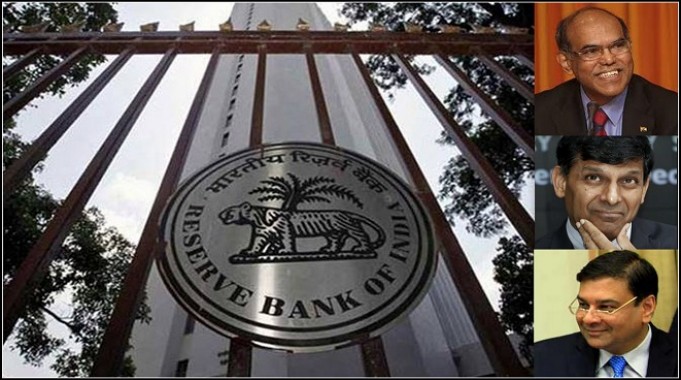Media’s escalating romance with RBI governors
The RBI and its governors--top to bottom: D Subba Rao, Raghuram Rajan, and Urjit Patel
There used to be a time when not more than 500 people knew who the Governor of the Reserve Bank of India (RBI) was. It was a very important job but a low profile one in which the population at large didn’t have much interest.
All that changed after the 1991 economic reforms when the RBI was asked to spruce up the rules governing the financial sector and modernise it so that India could tap foreign savings to help with its investment needs. Between the 1993 and 1998, the RBI set about the task quietly. The media took note but in an absent-minded sort of way. Most of the coverage was confined to the business papers.
Then in 1998 came the Asian financial crisis and general interest perked up. The non-business press also started giving the RBI more space. In this noble effort it was aided by the media friendly personae of the new Governor, Bimal Jalan. Over the next five years, without taking centre-stage, he brought the RBI to the forefront of economic and business news. The reason he gave was the need to for the RBI to communicate with the financial markets. The most effective tool for this was the media.
In 2003, Y V Reddy became the governor and took this process forward. He gave many speeches and talked more often to the media. By now TV news had come into its own, so that while the extent of the coverage increased, its quality declined. This was also the time when India was attracting an unprecedented amount of dollars as investment into the stock and bond markets. The drought of the previous half century was over.
The media responded with breathless excitement and by the end of 2005, the RBI Governor had become a celebrity to match at least one of the Bollywood Khans, if not the Big B himself. If Reddy was media savvy, his successor D Subbarao was media hungry. He took the Governor’s media exposure to another level altogether but kept it professional.
Then came Raghuram Rajan with his good looks and remarkable intellect. The combination felled everyone, most notably ladies who write columns. He started giving the Big B a run for his money. The RBI Governor had become a top star in his own right.
The result has been gushiness of amazing proportions. The announcement of his departure was greeted by the media by howls of dismay and squeals of despair. Likewise the appointment off his successor, Urjit Patel, has also been accompanied by an uncritical acceptance of the government line. Indeed, the media seems to have lost all sense of proportion in the amount of space or time it has devoted to what is, in the end, a routine technocratic appointment that means little to the citizen.
But if this flaw in the news columns was induced by the ‘rock star’ aspect of Dr Rajan -- thrust upon him by the media itself – the editorials could have been written by Mr Arun Jaitley. All said exactly the same thing, that he would bring continuity to the job because he had worked as Dr Rajan’s deputy. The emphasis was exactly on what the government wanted -- continuity and no sudden rocking of the boat. It was taken for granted that absolutely the best decision had been taken. Even Mr Narayan Murthy of Infosys who had wanted Rajan to be given two more five year terms, praised Mr Patel’s accession.
No one questioned Mr Patel’s fitness for the job. No one examined the process. The Hindu which is trying to smarten itself up wrote in its welcoming editorial of Mr Patel “as someone who largely keeps his own counsel and prefers a low-profile and discreet working style, Dr. Patel is unlikely to grab headlines as frequently as his plain-speaking predecessor has done. And that is another factor that must have weighed in his favour.”
I hope it is right.
The Times of India’s edit could have been written by a trained sub-editor. It harped on continuity and regurgitated Dr Patel’s academic qualifications and predilections.
“Perhaps Patel’s greatest asset is that while he shares many of Rajan’s policy goals and has the right skills for the job, he is likely to be low key and less flamboyant than his predecessor, therefore less likely to rub the government the wrong way”. It did, however, say that Mr Patel should be more circumspect than Mr Rajan was.
One would have thought the Indian Express would have written something but didn’t. The weekend announcement must have caught it off guard. The Telegraph also did not write.
None amongst the business papers departed from the government script, either. All focused on continuity and the clone aspect of Mr Patel. Yet, in 2008, the clone-ness of Rakesh Mohan to Y V Reddy is what had prevented his appointment as Governor.
There will be another media frenzy in about two weeks from now when Mr Rajan demits office and Mr Patel takes over. The same things will be said once again, to what avail no one knows.
One must hope that in the next three years, Mr Patel will restore his offices to the old, below-the-radar existence because the RBI governor cannot really compete with the finance minister on adversarial terms, which is what the media enjoys and hopes for. His job is the manage the government quietly outside the media’s attentions, not quarrel with it in full media glare.
